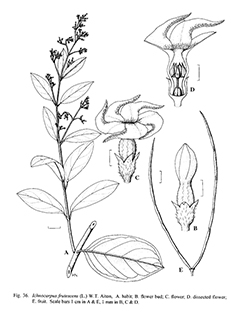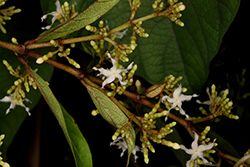e-Flora of Thailand
Volume 7 > Part 1 > Year 1999 > Page 113 > Apocynaceae > Ichnocarpus
1. Ichnocarpus frutescens (L.) W.T.Aitonwfo-0000217289
Hort. Kew. ed. 2, 2: 69. 1811; Kurz, FI. Burm. 2: 185. 1877; Hook.f., Fl. Br. Ind. 3: 669. 1882; King & Gamble, J. As. Soc. Beng. 74(2): 493. 1907; Ridl., Fl. Malay Penins. 2: 364. 1923; Pitard, Fl. Gén. I.-C. 3: 1255. 1933; Kerr, Fl. Siam. En. 2: 466. 1939; Backer & Bakh.f., Fl. Java 2: 239. 1965; Tsiang & PT. Li, FI. Reip. Pop. Sin. 63: 225. 1977, Lý, Fedd. Rep. 97: 675. 1986; Forster, Aust. Syst. Bot. 5: 536. 1992; Middleton, Blumea 39: 77. 1994; Li et al., Fl. China 16: 186. 1995.— Apocynum frutescens L., Sp. Pl. 312. 1753. Fig. 36.
Accepted Name : This is currently accepted.
Synonyms & Citations :
Description : Branchlets pubescent or shortly tomentose, often becoming glabrous and lenticellate when older. Leaves: petiole 3.5–14(–29) mm long; blade papery to subcoriaceous, elliptic or ovate, 2.3–12.5 x 0.7–7 cm, 1.3–4.4 x as long as wide, apex acuminate or more rarely acute or obtuse, base cuneate to rounded; secondary veins 4–8 pairs; commonly pubescent on midrib beneath, more rarely glabrous or tomentose all over beneath; glands present or absent in leaf axils and on interpetiolar ridge. Inflorescence 1.5–13(–17) cm long; axillary and terminal; usually shortly tomentose, sometimes becoming glabrous. Sepals ovate or triangular, 0.8–1.8(–2.4) x 0.5–1.1 mm, apex acute, rarely acuminate or obtuse; sparsely to densely pubescent or shortly tomentose. Corolla white or yellowish; tube 1.8–3.2(–4) mm long; lobes longer than the tube, 2.6–6 mm long, upper part consisting of a strap-shaped projection to the right; outside glabrous, pubescent only on tube or pubescent on tube and the part of the lobes exposed in bud, lobes usually ciliate, mouth densely villous, upper part of tube inside glabrous or sparsely pubescent. Stamens inserted at 0.9–1.4 mm from base; anthers 0.9–1.1 x 0.3–0.5 mm. Disk 0.4–1 mm long, lobes narrow and free, slightly bulging on top. Ovary 0.3–0.7 mm long, pubescent; style + pistil head 1.1–2 mm long. Fruit 3–10.5(–17.1) cm long, 1.6–5 mm wide; tomentose, often becoming glabrous. Seeds 1.9–2.4 cm long, 0.8–1 mm wide; coma 1.8–3 cm long.
Thailand : NORTHERN: Chiang Mai, Lampang, Phitsanulok, Nakhon Sawan; NORTH-EASTERN: Loei, Kalasin, Maha Sarakham, Khon Kaen; EASTERN: Chaiyaphum, Nakhon Ratchasima, Surin, Si Sa Ket, Ubon Ratchathani; SOUTH-WESTERN: Kanchanaburi, Ratchaburi, Phetchaburi, Prachuap Khiri Khan; CENTRAL: Lop Buri, Suphan Buri, Ang Thong, Saraburi, Nonthaburi, Krung Thep Maha Nakhon (Bangkok); SOUTH-EASTERN: Prachin Buri, Chon Buri, Rayong, Chanthaburi, Trat; PENINSULAR: Chumphon, Surat Thani, Phuket, Nakhon Si Thammarat, Phatthalung, Trang, Songkhla, Narathiwat.
Distribution : From India and China to Sri Lanka (type), the Philippines and N Australia.
Ecology : Climber in mixed deciduous, evergreen or swamp forests, or more rarely a scrambler in open areas, sea level to 850 m alt.
Vernacular : Kruea chen (เครือเจ็น)(Chiang Mai); chai song (ชัยสง), khruea sut (เครือซุด), khruea sut daeng (เครือซุดแดง)(Loei); thao yot daeng (เถายอดแดง)(Ang Thong); hun nam (หุนน้ำ)(Saraburi); thao wan daeng (เถาวัลย์แดง), hua khwan (หัวขวาน)(Chon Buri); tao hai (เต่าไห้)(Trat).
Notes: This is an extremely widespread and variable species.


